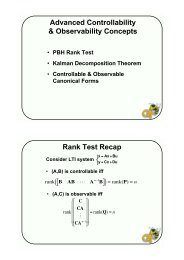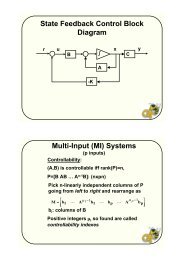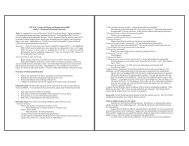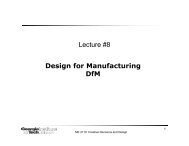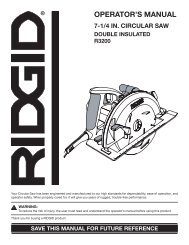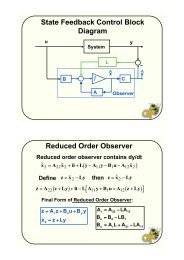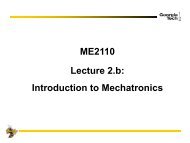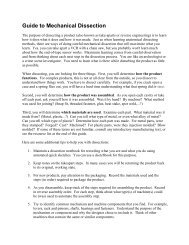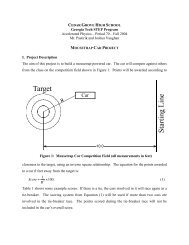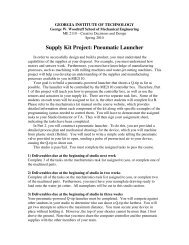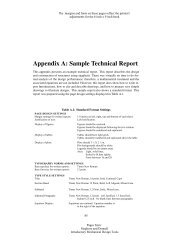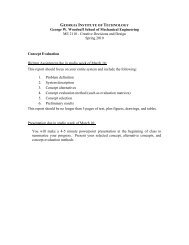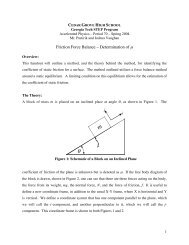Projectile Motion Lab Handout - Singhose
Projectile Motion Lab Handout - Singhose
Projectile Motion Lab Handout - Singhose
You also want an ePaper? Increase the reach of your titles
YUMPU automatically turns print PDFs into web optimized ePapers that Google loves.
CEDAR GROVE HIGH SCHOOL<br />
Georgia Tech STEP Program<br />
Accelerated Physics – Period 70 – Fall 2004<br />
Mr. Pastirik with Joshua Vaughan<br />
PROJECTILE MOTION LABORATORIES REPORT<br />
In the last two weeks we have explored projectile motion. We have completed two labs which<br />
investigated such motion. In these labs, we investigated the effect of varying the initial height of<br />
the projectile, and, in the second lab, the launch angle of it. We found that the distance a<br />
projectile travels is affected by both. You will now write a lab report that summarizes the results<br />
and compares them to theory. Some information that will help you do this is presented in the<br />
following section. The report expectations, suggested outline, and required formatting are then<br />
presented.<br />
The Theory Behind the <strong>Lab</strong>s<br />
A schematic of the projectile, shown as a point M (you’ll later learn why I choose this letter), at<br />
the instant after firing is shown in Figure 1. The vector V i indicates the initial velocity vector,<br />
while the scalar values of v xi and v yi indicate the horizontal and vertical components of this<br />
vector. The initial height of the projectile, measured from the ground, is indicated by the<br />
variable h. The launch angle is indicated by the variable q.<br />
vyi<br />
Vi<br />
M<br />
q<br />
vxi<br />
h<br />
Figure 1: Schematic of the Dart at the Instant after Launch<br />
1
Using the variables defined in Figure 1 we can find equations that give us the position of the<br />
projectile at any given time (see page 102 of your text for a similar example). They are:<br />
x(t) = v i<br />
cos(q)t (1)<br />
y(t) = - 1 2 gt 2 + v i<br />
sin(q)t + h. (2)<br />
†<br />
†<br />
Let’s examine these equations in the context of each lab.<br />
The First <strong>Lab</strong> – Distance vs. Launch Height<br />
Notice that, for the first lab, our guns were positioned horizontally, so q was zero. Equations (1)<br />
and (2) then reduce to:<br />
x(t) = v xi<br />
t (3)<br />
y(t) = - 1 2 gt 2 + h. (4)<br />
†<br />
†<br />
†<br />
We can solve these equations to find the horizontal distance traveled (in the x direction) for a<br />
given height, h, and initial velocity in the horizontal direction, v xi . We find that:<br />
x(t) = v xi<br />
2h<br />
g<br />
The general trend of this equation, assuming an initial velocity, v xi , of 10<br />
Distance (m)<br />
6.5<br />
6<br />
5.5<br />
5<br />
Distance<br />
†<br />
m<br />
s<br />
(5)<br />
is shown in Figure 2.<br />
4.5<br />
1 1.2 1.4 1.6 1.8 2<br />
Initial Height (m)<br />
Figure 2: Distance vs. Initial Height<br />
2
The Second <strong>Lab</strong> – Distance vs. Launch Angle<br />
For the second lab, we kept our guns at a constant height, which was very close to the ground.<br />
Because it was held constant, and was small relative to the distance our projectile traveled, we<br />
can ignore it in Equation (2). Equations (1) and (2) then reduce to:<br />
x(t) = v i<br />
cos(q)t (6)<br />
y(t) = - 1 2 gt 2 + v i<br />
sin(q)t. (7)<br />
†<br />
†<br />
†<br />
We, just as before, can solve these equations to find a distance traveled (in the x direction). This<br />
time, the result relates the distance to a given initial speed, v i , and the launch angle, q. Notice<br />
that these two parameters can be used to define the initial velocity, V i . We find that:<br />
x(t) = 2v 2 i<br />
cos(q)sin(q)<br />
. (8)<br />
g<br />
The general trend of this equation, assuming an initial velocity, v i , of 10<br />
Distance (m)<br />
12<br />
10<br />
8<br />
6<br />
4<br />
2<br />
Distance<br />
†<br />
m<br />
s<br />
is shown in Figure 3.<br />
0<br />
-2<br />
0 10 20 30 40 50 60 70 80<br />
Launch Angle (deg.)<br />
Figure 3: Distance vs. Launch Angle<br />
The Report<br />
Using the knowledge of projectile motion that you have gained in the last two weeks, and the<br />
information presented above, you will now write a report summarizing the two labs and<br />
contrasting the results obtained with the results that you should expect from theory. In the<br />
3
eport, you should outline the experimental method of each of the labs, and the results obtained<br />
from each. You should then relate these results to the theory. You should, for each experiment,<br />
plot the experimental results and the theoretical results on the same graph. To get as close a fit<br />
as possible, vary the initial velocity in Equations (5) and (8) to get as close an agreement as<br />
possible (remember that this value should be very close to the same for each experiment). In<br />
general, your results will not match the theory exactly. This is okay. You must, however,<br />
explain why this is so. To do this, think about possible sources of error in your experiments,<br />
what assumptions we generally make when talking about projectile motion, and the assumptions<br />
we made in finding Equations (5) and (8) (Hint: in Equation (8), is h actually zero?).<br />
The outline for the report is below:<br />
Title Page<br />
Abstract<br />
This should summarize the results and discussion that are presented in your report, and be<br />
included, at the beginning, on a separate page.<br />
Introduction<br />
This section should introduce (hence the name) the theory behind the experiments. It will<br />
be very similar to the first part of “The Theory Behind the <strong>Lab</strong>s” section of this handout,<br />
including the equations and figure. In this section you should also include a hypothesis<br />
for each experiment and an outline for the rest of your report. This section should<br />
conclude with a sentence of the form.<br />
In the following sections, …<br />
Here the … should include and outline of the sections of your report. This sentence<br />
provides the reader with a roadmap of your report.<br />
Experiment Setup 1<br />
This section describes the first lab setup and procedure. IT DOES NOT PRESENT THE<br />
RESULTS FROM IT.<br />
Experimental Setup 2<br />
This section describes the second lab setup and procedure. IT DOES NOT PRESENT<br />
THE RESULTS FROM IT.<br />
4
Results and Discussion<br />
This is the section where you present the results from your experiments. It should<br />
include the theoretical and actual results (on the same graph) for each experiment. You<br />
should also indicate the value you found for initial velocity in each. You should include<br />
the discussion on the disagreement between the theory and experimental results. Use the<br />
graphs you develop as support.<br />
Conclusion<br />
Very briefly summarizes the results and discussion presented in the report. This is very<br />
similar to the abstract. Contrary to the name, no new information or conclusions are<br />
presented in this section.<br />
Report Guidelines<br />
A template with correct page format can be found on the class website. If you need help<br />
changing these settings, please ask for it. “I didn’t know how to change the settings” is not an<br />
acceptable excuse for incorrect formatting.<br />
Tutorials on how to insert equations, figures, and graphs can also be found on the class website.<br />
If you need help, please ask for it. “I didn’t know how to insert an equation, figure, or graph” is<br />
not an excuse for not having them, or doing them by hand.<br />
1. One report per group will be collected.<br />
2. MAXIMUM page length, not including the title page, abstract, figures, and graphs, is 2<br />
pages. Spelling and grammar should be correct.<br />
3. The report must be computer generated, including figures, graphs, and equations.<br />
4. Text should be 12-point font, Times or Times New Roman, 1.5 line spacing, justified.<br />
5. Page margins should be 1 inch all the way around.<br />
6. Figures and should be numbered and have descriptive captions.<br />
7. Equations should be numbered.<br />
8. When talking about a figure or graph refer to it by number. For example, blah blah blah<br />
is shown in Figure 1. Or, Figure 2 is a plot of blah blah blah. (Replace the blah blah blah<br />
with the actual description of the figure or graph)<br />
9. Cleary indicate sections. Use bold type for the heading. You should space one line<br />
between the previous paragraph and the section heading. (See the section breaks in this<br />
document). Subsections can be indicated by a similar space and italic type.<br />
5



